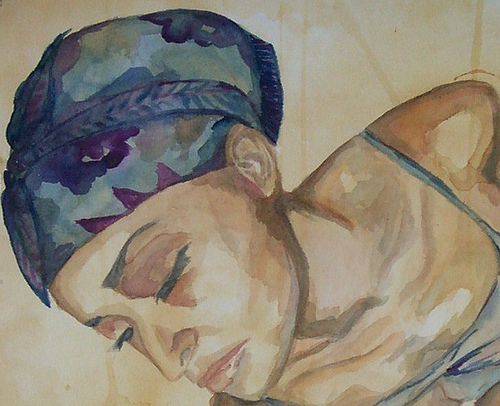
Designing an Art Curriculum Based on Educational Theory
[flickr id=”8121856138″ thumbnail=”medium” overlay=”true” size=”original” group=”” align=”none”]
Throughout the course of this program, I have been introduced to a variety of educational theories and teaching methods. As this program progresses and gets closer to student teaching, the time to think about which educational theories and teaching methods to actually implement in my future classroom draws near. A few of the theories that have been introduced to me that are in line with my vision of teaching are Discipline Based Art Education (DBAE), Studio Thinking, and Constructivism. On the offset DBAE and Constructivism seemed to be conflicting ideologies to me, because I viewed DBAE as more of a Behaviorist approach to teaching where the teacher was the “gatekeeper” of knowledge, as opposed to the more student-empowering approach of Constructivism. With more research, I’ve come to believe that with intentional curriculum planning, the two can be combined to create a fluid and meaningful art education experience.
When I tell people I am getting a Masters in Art Education, too often and much to my chagrin, the response is something along the lines of, “Oh that’s adorable. You’ll get to paint with kids all day!” That is a partial truth, but it is a very small part of a huge job. I believe there are a few reasons why people respond this way, the biggest reason being that their own art education experience somehow lacked substance and did not transfer in any meaningful way to the other subjects they were learning in school.
The theory of Discipline Based Art Education seeks to remedy that by incorporating the historical and critical aspects of art into studio-based classes. This puts art-making into context for students who are not innately inclined to studio work and do not plan to pursue art beyond their high school graduation requirement. DBAE focuses on how to interpret, analyze, and appreciate art. Interpretation, analysis, and appreciation are all parts of a larger whole—critical thinking, a highly transferable skill.
Another reflective, critical thinking enhancing art educational theory is Studio Thinking. The eight Studio Habits develop a mindset in students that is transferable to all of the arts disciplines, as well as other subjects. Studio Habits of Mind such as Engage and Persist translate well into any significant mental effort, while Studio Habits like Observe are helpful skills that cross over into the sciences. Once students are trained to think in these eight ways in a studio art setting, they can begin, possibly without even realizing it, to apply these critical thinking skills to many of their other academic efforts, whether they pursue art further or not.

Lev Vygotsky was one of the foremost theorists of the Constructivist movement. Umm also, what a cutie patootie! Too bad he died in 1934 at the age of 38 from tuberculosis… and we never met. We may or may not refer to him as “Love” Vygotsky in class.
Constructivism places more responsibility in the hands of the student and seeks to have the student be actively involved in the learning process, unlike the theory of Behaviorism where the teacher is the only source of learning and the student’s role is passive and receptive. I believe that a Constructivist learning environment, where I, as the teacher, would take on a role that is more focused on facilitating learning experiences, also enhances a student’s critical thinking capabilities. Students under my guidance will have to think about what they want to come away with from their studio experience and pursue that expectation. Constructivism, according to Vygotsky’s contribution to the theory, also encourages learning in a social, cooperative context, which fits very well with art education in my opinion.
So, how do these three theories come together in one classroom, and how can they be implemented into a curriculum? The first and most easily accessible way to implement Constructivism is in my classroom set-up. At least one day of each month, students will take a break from the main project they are working on for a purely self directed student exploration of an essential question (e.g. “How does art imitate life?”). Students will have access to common and safe art materials, and there will be designated work areas for different media. One table will be for drawing, the other for painting, another for collage, and another for recycled materials. Students will choose a table to work at to explore the essential question, or they can move among the different tables to complete their exploration. They will be encouraged to discuss their ideas with each other, but each student must complete their own assignment and come to their own conclusion of what the essential question means to them.
To be completely honest, I am a big fan of Constructivism, but I struggle with the notion of having a purely Constructivist classroom where I am only in a facilitator’s role every single day. That is where the aforementioned idea of student self-directed exploration days came to mind. I plan to regularly use Constructivist principles in many of my classroom activities, such as student-lead critiques and collaborative assignments. However, in a classroom based purely on Constructivism, I would worry about how I was getting students to meet and exceed the standards on a daily basis. It would take a great deal of planning on my part, as well as on the part of the students as they would need to come prepared with their own learning goals and expectations, be well equipped to take initiative, and be decisive in how they would be meeting those goals.
How would DBAE and Studio Thinking fit in? As I stated earlier, DBAE provides the context for studio art. By providing a foundation for students to understand art history, art criticism, and aesthetics, in addition to technical studio work, I am showing them how art fits into the greater scheme of world history, the evolution of our perceptions of beauty, and how we assess an object’s value from a visual standpoint. One of the most obvious ways to practice DBAE is in an introductory critique of a work of art. Before beginning a new unit, I would use VTS to have students analyze a work of art and draw conclusions about where it is from and what could possibly have been going on historically when it was made.
In my opinion, Studio Thinking is the most practical and easily implemented theory, and it’s also the theory I’ve seen at work in high school art classrooms the most frequently. In my curriculum, the Studio Habits of Mind would be sewn into every project, and I would give students a chance to explain in critique and in writing which Studio Habits they used and how they used them. My rubrics, which I would share with my students for each assignment so they know what they are going to be graded on before completing their art piece, would also set up the expectation that students work within the Studio Thinking mindset.
Having a curriculum that fosters reflection, initiative, and critical thinking is essential to a meaningful art education. Not only do they provide the framework for a challenging art experience, but the skills that are developed in theories such as DBAE, Constructivism and Studio Thinking transfer into every aspect of learning and how students provide evidence of learning. Contrary to the opinions of the occasional dolts that tell me my career choice is adorable, teaching and learning art is an intentional practice that is foundational to every other academic endeavor.
